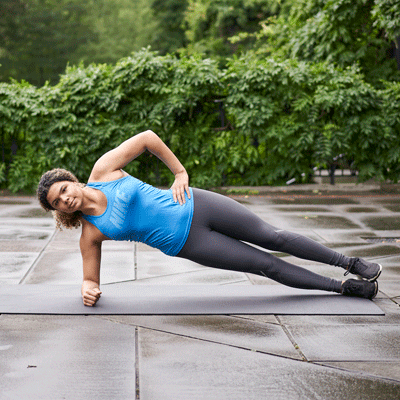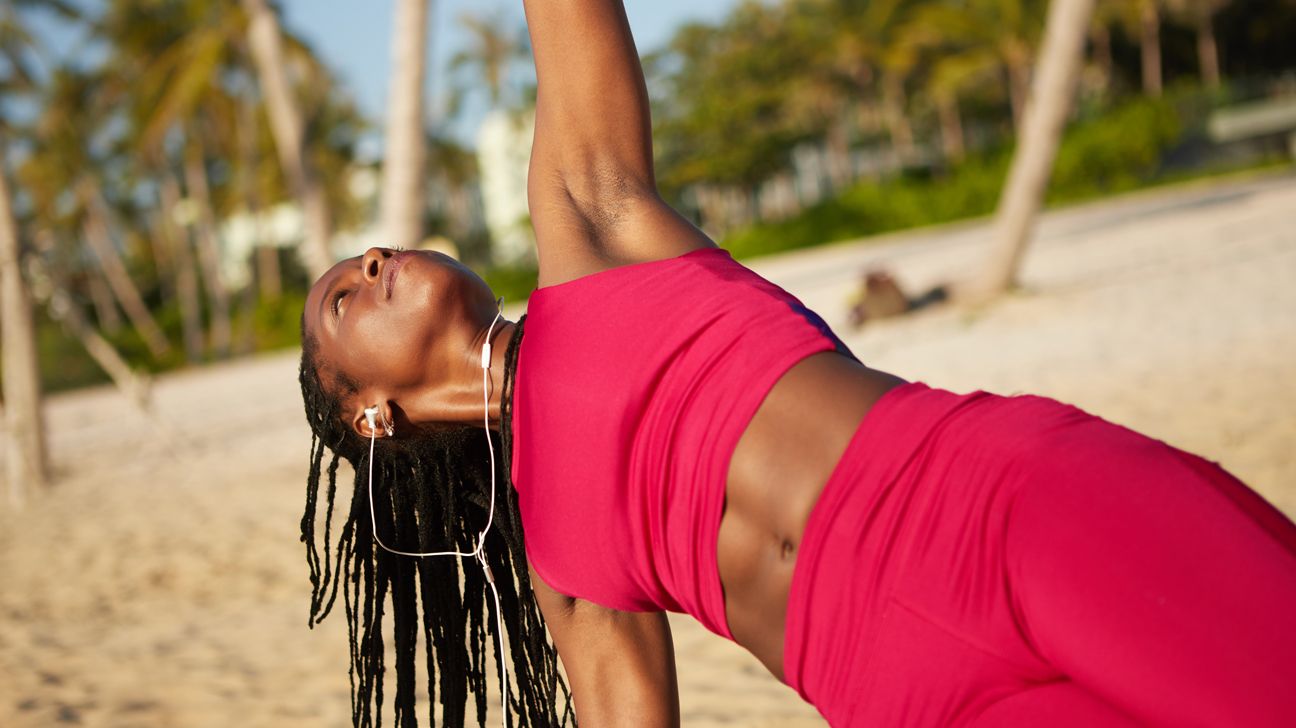The side plank might seem basic, but it’s actually a killer workout. It’s a unilateral exercise that engages your whole body. In addition to your core, you’ll strengthen your shoulders, arms, hamstrings, back, and 🍑.
Here are 11 ways to reach your #BodyGoals with the side plank.
First things first: If you’re new to planking, you should master the basic forearm plank before moving on to variations, says certified personal trainer Riley O’Donnell.
When you’re doing a basic forearm plank, your body weight should be supported by both forearms and both feet. Make sure your elbows are directly under your shoulders. It helps to imagine your body as a straight line from head to toe.
Once you’ve built some confidence with a traditional two-handed plank, you’re ready to progress to a side plank.

To do a basic side plank:
- Lie on one side and straighten your legs.
- Position your elbow directly under your shoulder, with forearm pressed into the floor.
- Lift hips and squeeze your glutes as hard as you can.
- Pull belly button in toward spine and drive elbows toward toes.
Suggested reps and sets
- Beginner: Hold 10 seconds, 3x on each side.
- Intermediate: Hold 30 seconds, 2x on each side.
- Advanced: Hold 60 seconds, 1x on each side.
According to physical therapist Varsha Seemangal, people often forget about side planks and focus on forward planks. Well, that’s about to change!
Side planks are amazing for your core. Having a strong core can decrease chronic back issues. That’s good news for the 80 percent of Americans who will experience low back pain at some point in their lives.
In addition to your core, side planks work your:
- hips
- chest
- shoulders
- wrists
- legs
- butt
- lower back
- obliques
You’ll also feel the burn in your transverse abdominus. These muscles are located deep within your core and help protect your spine. Additionally, planking can improve your overall stability, balance, and coordination. Woo!
Form is vital in any exercise. You gotta keep it tight. Sloppy form can lead to injuries and might impact your desired results.
Avoid the following plank faux pas:
- Head drop: Keep your head in a straight line with the rest of your body. If you let your head hang loose, you might end up with a gnarly neck strain.
- Shoulder shrug: Don’t dip your shoulders. Press the floor away from you with your forearm instead. This helps maintain the integrity of your shoulder joint, says Dyan Tsiumis, founder of ALL OUT Fitness from the Inside Out.
- Saggy hips: It’s all in the hips, friends. If you drop your hips, your spine won’t be aligned. To correct this, squeeze your glutes and engage your core. Make sure your hips are stacked.
- Squeeze that tushy: Glute engagement is key in supporting your obliques during planks. So tighten those hot buns!
Rome wasn’t built in a day, and neither is a six-pack. Take it plank by plank.
In addition to the basic forearm plank, O’Donnell recommends mini band step-outs as you work toward more intense variations.
Still working on your side plank strength? Try this beginner kneeling side plank before you build up to the regular side plank:
- Lie on one side with your knees bent.
- Position your elbow directly under your shoulder, with forearm pressed into the floor
- Press up to a side plank (only your thighs and hips should leave the floor — knees stay on the floor).
Looking for an even bigger upgrade to your current planking routine? We’ve got 9 variations your core will hate/thank you for.
1. Kneeling side plank with leg lift
Muscles engaged: Entire core and glutes
How-to: Start in kneeling side plank on your right arm. Then extend your left leg out to the side. Your weight should now be supported by right arm and knee. Slowly lower your left leg until toes touch the floor. Squeeze your inner thighs and lift left leg back to the starting position. Complete 3 sets of 8–12 reps per side.
Modification: Come back to the kneeling position if you need a rest.
2. Side plank thread-through
Muscles engaged: Shoulders, lats (upper back), glutes, abs, and obliques
How-to: Start in side plank position. Reach your top arm toward the ceiling. Wrap your top arm around your body like you’re giving yourself a hug. Thread your arm through the space under your plank until your shoulders are almost parallel to the floor. Unthread and return to the starting position. Complete 3 sets of 8–12 reps per side.
Modification: Staggering your feet will give you more stability. You can also bend your top leg and plant your foot on the floor for an assisted side plank.
3. Side plank knee to elbow
Muscles engaged: Shoulder, lats, glutes, and obliques
How-to: Start in side plank on your forearm or hand, making sure shoulder and elbow/wrist are stacked. Reach your top arm in the direction of the top of your head. Keeping the hips high, pull your top elbow down and drive top knee to meet the elbow. Return to the starting position. Complete 3 sets of 8–12 reps per side.
Modification: Rest your bottom knee on the floor for support if needed.
4. Side plank hip dip
Muscles engaged: Shoulder, lats, glutes, and obliques
How-to: Start in forearm side plank, making sure your shoulder and elbow are stacked. Keeping hips stacked, lower the hips 2–4 inches toward the floor. Then drive the hips up 4–6 inches. Complete 3 sets of 10–15 reps per side.
Modification: Stagger your feet for more stability. You can also bend your top leg and plant your foot on the floor for assistance. For a bigger challenge, lift your top leg.
5. Side plank with lateral raise
Muscles engaged: Obliques, arms, legs, and shoulders
How-to: Start in forearm side plank with legs stacked. Hold a dumbbell in your top hand, with your arm resting along the side of your body. Slowly raise the weight, making sure not to extend beyond your shoulder. Lower your arm back down. Complete 3 sets of 8–10 reps per side.
Modification: Skip the weight and just use your bodyweight.
6. Gym ball side plank
Muscles engaged: Core, shoulders, lateral hips, and legs
How-to: Get into side plank position, but instead of resting your forearm on the floor, rest it on an exercise ball. Move your front leg forward instead of stacking your legs for more stability. Keep top hand on hip or raise it toward the ceiling. Hold the position for 30 seconds on each side; do 3 sets.
Modification: You can also use a BOSU ball.
7. Elevated side plank
Muscles engaged: Deep core, obliques, and shoulders
How-to: Get into a side plank position with forearm on the floor and feet on an elevated surface (a bench, box, step, or chair). Contract your abs, pulling the belly button in toward the spine. Raise the hips so your body forms one straight line from top of head to feet. Hold for 30 seconds on each side; do 3 sets.
Modification: Not challenging enough? Move onto your hand.
8. Side plank with leg lift
Muscles engaged: Shoulders, obliques, hip abductors, and glutes
How-to: Start in forearm side plank (or start on you hand). Place your top hand on your hip or extend it toward the ceiling. Engage your core, pull the belly button in toward the spine, and lift your top leg just higher than hip height (keeping the feet flexed). Lower back down. Complete 3 sets of 15–20 reps per side.
9. Alternating side plank
Muscles engaged: Shoulders, triceps, core, and obliques
How-to: Start in a forearm plank, making sure your shoulder and elbow are stacked. Press your left forearm into the floor below shoulder to rotate into side plank. Rotate from side plank into standard plank as you press your right forearm into the floor into a side plank on the other side. Reverse the movement to return to the starting position. Complete 3 sets of 5–8 reps per side.
Modification: Move onto your hands for a challenge.
Planks are pretty safe. But with any exercise, you have to be careful. Listen to your body’s limits. This is particularly important if you’re new to #PlankLife.
Avoid planking if you’re:
- recovering from surgery
- experiencing acute low back, neck, or shoulder pain
- experiencing dizziness/lightheadedness/vertigo
Side planks are the bomb. Incorporate planks into your workout routine three or four times per week to improve stability, strength, and stamina. Just be patient with the process. Aim for 60-second holds and work toward your goal one plank at a time!


